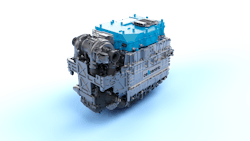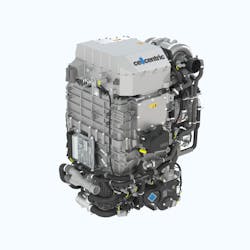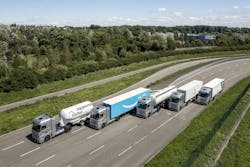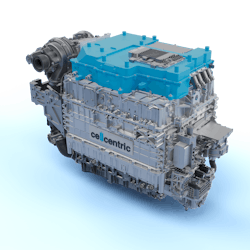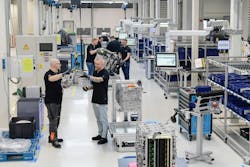Hydrogen fuel cell tech is growing even more long-haul capable
ANAHEIM, California—Hydrogen powertrain technology is improving rapidly. Backed by major European truck manufacturers, one of the leading hydrogen fuel cell developers is making great strides toward mass production of a system that can match—and in some ways exceed—diesel performance.
The costs of hydrogen fuel cell systems—and the fuel itself—still exceed those of average diesel powertrains. But if analysts are correct in predicting hydrogen production will rise and prices will fall, these systems could be the ideal zero-emission technology for long-haul loads.
Cellcentric, a joint venture of Daimler Truck and Volvo, is utilizing some of the world’s most experienced hydrogen experts to develop advanced hydrogen systems with impressive stats backed by real-world testing.
See also: International’s newest Class 8 truck is about proving EV TCO
“We’re not that bad today,” Nicholas Loughlan, CTO of Cellcentric, told a room of journalists here in Anaheim. “The trucks we have on the road, with Daimler and Volvo, are capable of doing 1,000 kilometers (620 miles) and more, no problem, [with] 80,000 lb.”
With a proven range like that, hydrogen refueling could coincide with drivers’ hours of service limitations, significantly reducing long-haul range anxiety. Even better, Cellcentric is planning a hydrogen fuel cell system that could be even more efficient.
“If you want to make something successful, you need to tailor to the use case and tailor it to the customer … At the end of the day, it’s a business decision that drives this,” Loughlan said. “The powertrain and vehicle configuration that serves the customers’ use case and their business best—that is what will drive a purchase decision.”
Today: the BZA150
Cellcentric’s latest hydrogen fuel cell system boasts impressive specs.
The BZA150 weighs 551 lb. and outputs a continuous 143 kW (195 hp) at the beginning of its life. The trucks currently powered by the BZA150 run two systems at once, meaning the total powertrain weighs 1,100 lb. —less than many diesel integrated powertrains—and outputs 286 kW (390 hp). For trucks running real loads, the system’s fuel efficiency is roughly 8 miles per kilogram hydrogen.
The system has compact packaging, fitting within the same footprint as a traditional diesel powertrain. It is also durable and boasts an expected lifespan of 25,000 hours or 10 years, exceeding many modern diesel engines.
Real-world runs
The BZA150 has been the star of Daimler’s and Volvo’s hydrogen fuel cell truck trials in Europe.
In 2023, a Volvo FH electric ran a trial in the frigid Arctic Circle, and a fully loaded Mercedes-Benz GenH2 truck ran a record 650 miles on one fill of liquid hydrogen. For those 650 miles, the weight of a vehicle when “fully loaded” in Europe was heavier than U.S. weight standards: The tractor-trailer weighed 40 tons, or 88,000 lb.
In 2024, Amazon and other major European businesses began customer trials of five Mercedes-Benz GenH2 trucks using the BZA150 system.
See also: Peterbilt’s EV-olution continues: Launches vocational 567EV, next-gen 579EV
Tomorrow: the NextGen
The BZA150 is still far from Cellcentric’s plans for the trucking industry. The company is planning another system for large-scale production. According to its specs, the next system is leagues ahead of the already impressive BZA150.
Currently titled NextGen, the next system is a single system rather than tandem, making it roughly 40% less complex within the same small footprint. In addition, it produces more power, more efficiently: Its output is 375 kW continuous (more than 500 hp) for 20% less fuel consumption and almost half the waste heat when running at 300 kW net power.
The NextGen’s expected fuel consumption for heavy-duty trucking is 10.2 miles per kilogram hydrogen.
Future production plans
The company hopes to move from development to large-scale production of the NextGen system by 2030. They are already preparing for industrial production, and Cellcentric recently acquired land in Weilheim with plans to produce Europe’s largest fuel cell production factory.
The timeline gives the company time to thoroughly validate the system and its components, run pilot projects, and wait for greater hydrogen infrastructure development over the next years.
“We’re talking about a timeline that needs to be carefully aligned with infrastructure,” Loughlan said.
About the Author
Jeremy Wolfe
Editor
Editor Jeremy Wolfe joined the FleetOwner team in February 2024. He graduated from the University of Wisconsin-Stevens Point with majors in English and Philosophy. He previously served as Editor for Endeavor Business Media's Water Group publications.
